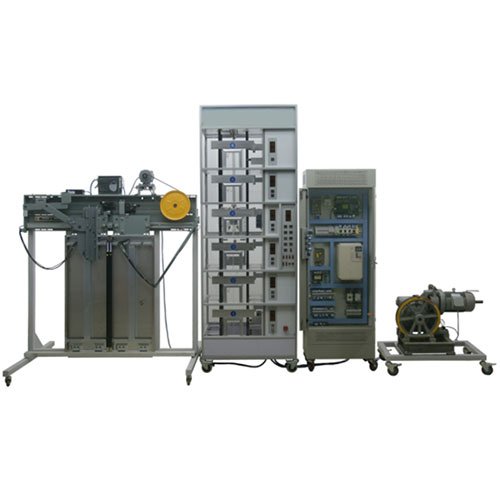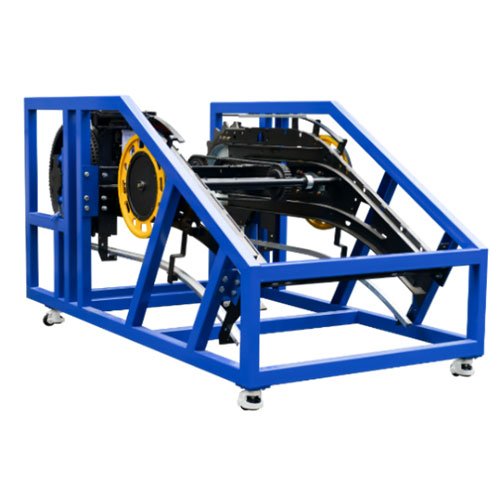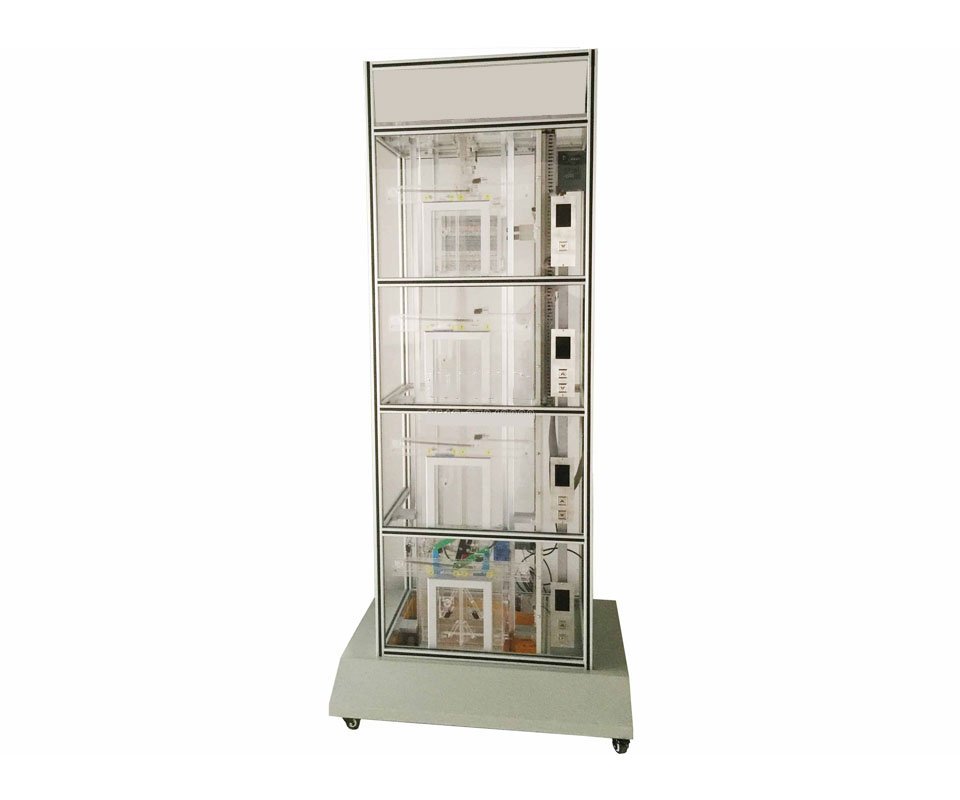- Automobile training equipment series
- Electrical and electronic teaching equipment
- Elevator training series
- Fitter training equipment
- Fluid mechanics experimental equipment
- Hydraulic and pneumatic test bench
- Mechanical teaching equipment
- Robotic automation and mechatronics series
- Welding training equipment
I. Overview
This elevator microcomputer-controlled traction motor debugging and testing device is designed as a demonstration and teaching device for elevator and industrial automation courses, including those for colleges, technical schools, vocational schools, employment training centers, and special equipment testing centers. This device consists of four main components: a transparent hoistway, an intelligent serial communication elevator electrical control system, a variable frequency door motor, and a traction motor. All key mechanical components of the elevator hoistway are constructed of transparent plexiglass and are meticulously scaled down to mimic the structure of a real elevator.
The electrical control system of the elevator microcomputer-controlled traction motor debugging and testing device utilizes an intelligent serial communication elevator control system. It includes a main controller (main computer board), car controller, command controller, and floor display controller for intelligent control, and a Yaskawa variable frequency drive (VVVF) for voltage, speed, and frequency regulation. The door motor utilizes a steel frame structure and includes the door motor inverter, light curtain, and landing door. The traction motor section includes a reduction gearbox, holding brake, and other components. During operation, the door motor and traction motor sections operate synchronously with the elevator car in the transparent hoistway, with functions and operating principles identical to those of an actual elevator. This allows trainees to observe the operation of the elevator car in the hoistway as well as the actual operating status of the landing door, car door, and traction motor. Mainboard and inverter parameters, as well as elevator speed and comfort settings, can be configured based on relevant electrical parameters. After hoistway self-learning, the data is automatically stored in the main control board.
II. Functional Description
1. Maintenance Operation:
When operating conditions are met, pressing the up/down button causes the elevator to jog at the maintenance speed. Pressing and holding the button causes the elevator to run, and releasing it stops it. Similarly, during maintenance, the door opening and closing buttons within the door zone also function as jog doors.
2. Full Select Control:
In automatic or operator mode, the elevator automatically responds to up/down call signals while in operation. Passengers on any floor can register up/down call signals to summon the elevator.
3. Automatic Door Opening at Arrival:
The elevator automatically opens its doors upon each leveling.
4. Automatic Door Opening Time Control:
When operating without a driver, the elevator automatically opens its doors upon arrival at a station and then automatically closes after a certain delay. If no call signal is registered when stopping at that floor, the delay is 2.5 seconds; if a call signal is registered, the delay is 4 seconds (default value). This delay can be set in the parameters.
5. Door Opening at Current Floor:
If the current floor call button is pressed, the car door automatically opens. If the button is held down, the door remains open. A buzzer will sound if the delay exceeds 1 minute.
6. Door Opening with Door Opening Button:
When the elevator stops at a door zone, you can press the door opening button in the car to reopen the elevator door, whether it is closed or not.
7. Stopping at a Different Station:
If the door remains open for 10 seconds without the door opening limit being activated, the elevator will enter the closed state and respond to the next call or command after the door closes.
8. Fully loaded direct travel:
When fully loaded in automatic mode, the elevator will not respond to passing call signals, only to command signals.
9. Arrival chime:
During the elevator’s deceleration and leveling process, the up and down arrival chimes mounted on the car roof or floor will sound to alert passengers in the car and those waiting outside the hall that the elevator is leveling.
10. Automatic car lighting and fan power-off during waiting time:
If there are no commands or hall calls registered for more than three minutes, the car lighting and fan will automatically power off. However, they will automatically power back on upon receiving a command or call signal.
11. Automatic return to base:
When operating without a driver, if the automatic return to base function is enabled, the elevator will automatically return to the base when there are no commands or calls.
12. Hoistway floor data self-learning:
Before the elevator officially starts operating, the system’s hoistway learning function is activated to learn various hoistway data (floor height, protection switch position, deceleration switch position, etc.) and save this operating data.
13. Driver Operation:
Driver operation can be selected by toggling the switch on the control panel. Driver operation provides the following functions: automatic direction, driver-selected direction, no automatic door closing (the driver must press the door close button to close the door. If the door is not fully closed, releasing the door close button automatically opens the door), and direct travel.
14. Driver Button Direct Travel:
In driver operation, if the direct travel button is pressed before the elevator starts, the elevator will not respond to calls during the next run and will proceed directly to the floor with registered calls.
15. Elevator Lock Service:
In automatic operation, setting the elevator lock switch cancels all registered calls. The elevator continues to operate normally, responding only to calls from within the car until no more calls are registered. It then returns to the base station, automatically opens the door, turns off the car lights and fan, illuminates the door open button, and automatically closes the door after a 10-second delay, stopping the elevator. Normal operation resumes when the elevator lock switch is reset.
16. Firefighter Operation:
When the system fire mode is set to Firefighter Mode, pressing the fire button immediately cancels all commands and calls, returns to the fire station, and then enters Firefighter Mode. In Firefighter Mode, the doors do not open or close automatically; they can only be opened or closed by pressing the door button. The elevator only responds to commands from within the car and cancels all registered commands upon arrival.
17. Voice Stop Announcement:
When the system is equipped with the voice stop announcement function, the elevator will announce the upcoming floor during each leveling process. Before each door closing, the stop announcer will predict the elevator’s next direction of travel, etc.
18. Door Safety Touchscreen Protection:
When the safety touchscreen is activated, the elevator door will open unconditionally. If the safety touchscreen is not deactivated, the door will not close.
19. Overload Protection:
When the overload switch is activated, the elevator door will not close, and a buzzer will sound.
20. Terminal Switch Overtravel Protection:
Both the upper and lower terminals of the elevator are equipped with terminal deceleration switches to prevent overtravel.
III. Control Cabinet Technical Parameters:
1. Control Cabinet Dimensions: Cabinet 400 (L) × 243 (W) × 1720 (H) mm
Resistor Box: 435 (L) × 230 (W) × 247 (H) mm
2. Input Voltage: AC 380 ± 7% 50 Hz (three-phase, five-wire)
3. Controller: NICE3000+
Motor Control Method: Closed-Loop Vector Control
Maximum Frequency: 99 Hz
Speed Range: 1:100 (Open-Loop Vector Control) 1:1000 (Closed-Loop Vector Control)
Speed Accuracy: ± 0.5% (open-loop vector control) ±0.05% (closed-loop vector control)
IP rating: IP20
9. Structure: 4-floor station
10. Landing layout: 4 floors, 4 stations, 4 doors
11. Electrical control cabinet weight: ≤100kg
IV. Door operator parameters:
1. Door operator dimensions: 1650 (length) × 1000 (width) × 1950 (height) mm
2. Control method: VVVF variable frequency door operator
3. Door opening width: 800 mm
4. Door opening method: Center-opening
5. Mounting method: Car top
6. Motor power: 90W 7. Motor speed: 960 r/min
8. Input voltage: AC 220V/50Hz
9. Current: 0.7A
10. Insulation class: Class F
11. Car door material: Stainless steel
12. Landing door material: Stainless steel
13. Weight: ≤200kg
V. Hoist parameters:
1. Synchronous traction machine dimensions: 680 (length) × 440 (width) × 251 (height) mm
2. Speed: 1.0/s
3. Traction ratio: 2:1
4. Load capacity: 450kg
5. Power: 3kW
6. Rated current: 7A
7. Traction sheave diameter: 320mm
8. Input voltage: AC 380±7%, 50Hz
9. Control method: (VVVF) variable frequency drive with voltage, speed, and frequency regulation
10. Brake voltage: DC 110V
11. Weight: 250kg
VI. Hoistway parameters:
1. Transparent hoistway dimensions: 900 (length) × 600 (width) × 2400 (height) mm
2. Hoist model: YS-5634W
3. Hoist reduction ratio: 1:15
4. Voltage: 3 × 380V
5. Power: 0.18kW
6. Speed: 1400rpm
7. Landing configuration: 6 floors, 6 landings, 6 doors
8. Car top control panel
9. Hall call display panel
10. Hall call display panel
11. Car command panel
12. Car top control box analog device





